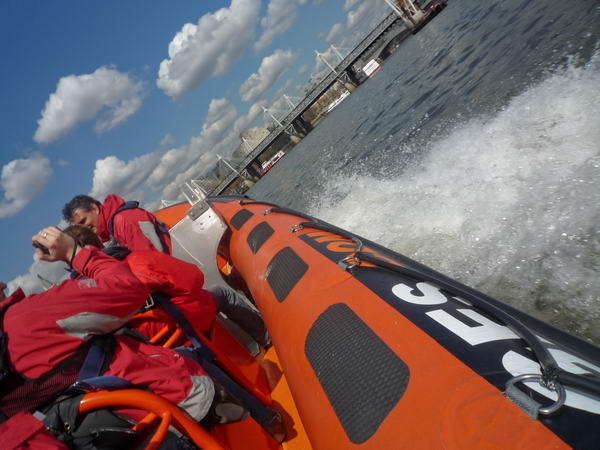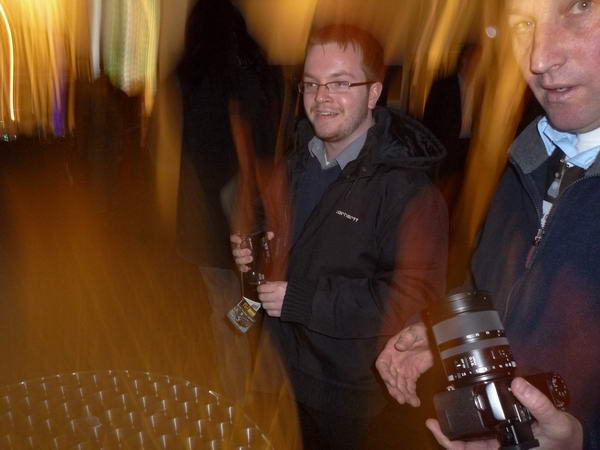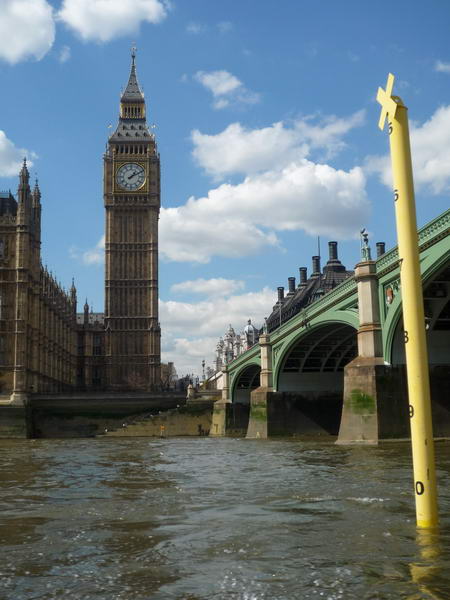I’ve often seen the RIB (Rigid Inflatable Boats) speeding along on the river and wondered what a trip in one would be like. Today, thanks to Panasonic, I got to find out. It actually felt surprising smooth and safe, although they did tilt at quite a steep angle when turning sharply at high speed, and I often felt a need to hold on with one hand while taking pictures. But it was enjoyable and rather more exciting than the conventional river trips, although these would be considerably easier to take photographs from.

If you are planning a trip to photograph London from the river, its also worth taking a look at the tide tables. When the tide is fairly low you do get the advantage of some uncovered sand and mud which might add pictorial interest, but at high tide the added height gives you a better viewpoint, as do the raised decks of some of the larger river boats.
Panasonic had invited a number of bloggers to come and look at their latest products, both in their Lumix range of still digital cameras and also their camcorders.

We met in Dali Universe, handily close to Waterloo station, and the morning started with an opportunity to handle the cameras and then a presentation about them. Panasonic came to still cameras late, but have from the start realised the need to offer new ideas, becoming one of the more innovative companies. Some of the ways they are doing this sound very interesting, such as intelligent exposure which can, among other things – and if I understood correctly, make use of different ISO speeds in different areas of the same image to produce more evenly lit effects when using flash.
Panasonic cameras also have benefitted greatly through cooperation with one of the most repsected firms in the business, Leica in lens design. It is perhaps the link-up with Leica that has enabled them to offer wider angles of view on their compact digitals, with 28mm or even 25mm equivalent as the widest angle of view on many of their cameras. Leica make some of the best wide-angles available for use on their M-series cameras, and I only wish I could afford a couple of their recent designs to use on my Leica M8, which gives the sharpest results of any digital camera.
After the talk we were allowed to choose a camera to get some hands-on experience with during a RIB river trip, which took us up close to Canary Wharf then back past the Houses of Parliament and then to the pier at the London Eye. It was an exhilarating journey.

Panasonic DMCFX-500
Given my preference for wide-angle lenses, I chose one of the new compact cameras with a 25mm lens to use on the trip, the Panasonic DMCFX-500. It’s a beautifully compact design and gives sharp 3648×2736 images, as I found under rather trying conditions of shooting from a RIB going rather fast along the Thames. If I needed a new compact for general use, this would be camera around the top of my list. It’s not fair to judge it from my limited trial under rather trying conditions, but it generally performed pretty well, and I imagine if I’d had the time to read the manual and fine tune things it would have done even better.
The colour was pretty good, the images were showed low noise. I left the camera on auto, and it was a sunny day, so almost all were at ISO 100). They had good detail with just a hint of over-sharpening (less than with the default settings of many compacts.)
But it isn’t my ideal camera. Despite the nice large clear viewing screen I still want an optical viewfinder, but that is fast becoming a lost cause. But what I had most problem with was shutter lag. Perhaps 20% of the pictures I took were not as intended, either because of the speed of the boat which meant the camera was pointing at something different by the time the picture was actually made or because I’d not held the camera still for long enough after pressing the shutter.
I blame Henri for this, Cartier-Bresson that is. Long ago I read his advice on taking pictures, about getting to know your camera so well that you could make all the settings needed without looking at your camera, then take pictures in a single rapid movement of the camera to your eye for the 1/125 of a second or so needed to frame and expose before bringing it down again. With a compact camera you need to remember to keep holding it steady for a second or so after you press the release, and the delay with the FX-500 seemed just a little longer than my current compact – so more pictures of the back of the seat in front of me than I really needed.
The camera also features image stabilisation, but either I didn’t have it turned on or the vibration on the RIB was just too much for it to cope with, and many of the images at longer focal lengths were unsharp due to camera shake. I didn’t see any problems with those taken on dry land, but mostly those were wide-angle pictures.
The screen image was large and very clear, possibly the best I’ve worked with in bright light. On auto, the camera also made some fairly intelligent decisions about when fill-flash was needed, although it wasn’t clever enough to spot the reflective clothing in one picture that always creates problems with its use.
Overall it seemed a nice camera to use, although I would need to get used to the shutter lag and for this reason wouldn’t choose it for action photography. But as a camera to put in your pocket for when you don’t have your Nikon or Canon DSLR it would be a reasonably versatile choice.
Examining the images back at home on my computer I was pleasantly surprised by the image quality. It seemed pretty even across the frame and there was little or no vignetting, perhaps thanks to the Venus4 engine. It looked as if this was also doing a fine job of removing chromatic aberration, as although there was some weak red cyan fringing, this could not hardly be improved using my usual software lens corrections. There was also a small amount of blue fringing visible, but not objectionable in any of the images I took.
The exposures were pretty consistent, and mainly more or less spot on, though in some cases a little highlight detail was clipped. I didn’t find out if it was possible to display a histogram or otherwise examine this. But there were quite a few images where it occurred to me that a RAW file would have been a great advantage. I don’t like to shoot jpeg, but most of these were very acceptable straight out of the camera, though almost all were improved slightly with a little tweaking in Lightroom.
Overall, although the Panasonic DMCFX-500 seemed to be a very good compact camera with the 25mm lens and image quality (at ISO 100 – not tried at faster speeds) a big point in its favour, but the shutter lag did seem worse than my current model, and the shot to shot time also seemed a little slower, although I didn’t measure it.
If you don’t already have a decent digital compact, the DMCFX-500 is certainly worth a look. It would be a good camera to take on a holiday where you wanted to travel light. Some people might prefer the longer 10x zoom range of the slightly less compact TZ5, but this would be my first choice
Video?
What really impressed me more than the still cameras was the amazing quality of the video made on the same boat trip using the Panasonic HDC-SD9 was amazing. We we were able to see it immediately on our return to Dali Universe, played back a a very large widescreen TV, and the colour, exposure and general image quality were superb.
Also impressive was the SDR-SW20, although the image quality is only DVD standard. This camera can shoot under water – even in the sea – up to 5 foot below the surface and is robust enough to juggle with (though you do need at least three for this.)
I was so impressed that I decided it was time to try video again and came away from the afternoon with the diminutive Panasonic SDR-S7, only 180g and fitting a pretty small pocket. Although I don’t think its likely I’ll stop using the Nikon D200 or Leica M8, perhaps soon you’ll see the occasional video added to this blog!
More pictures (but no video) from the day on My London Diary. All pictures in this post and the My London Dairy post were taken with a Panasonic DMCFX-500.